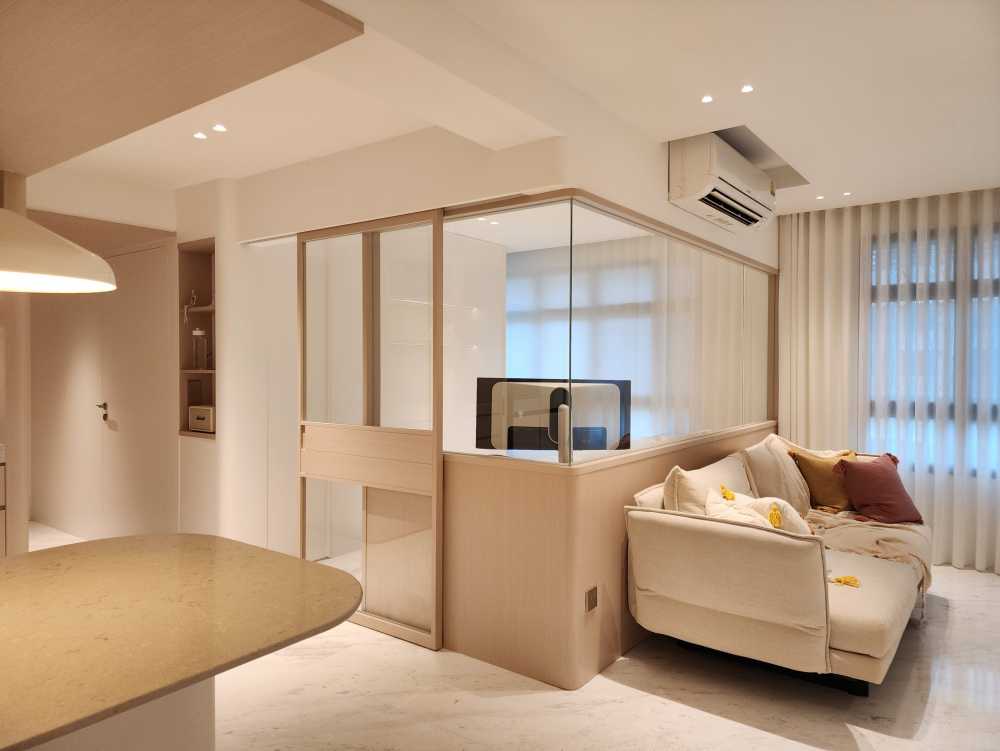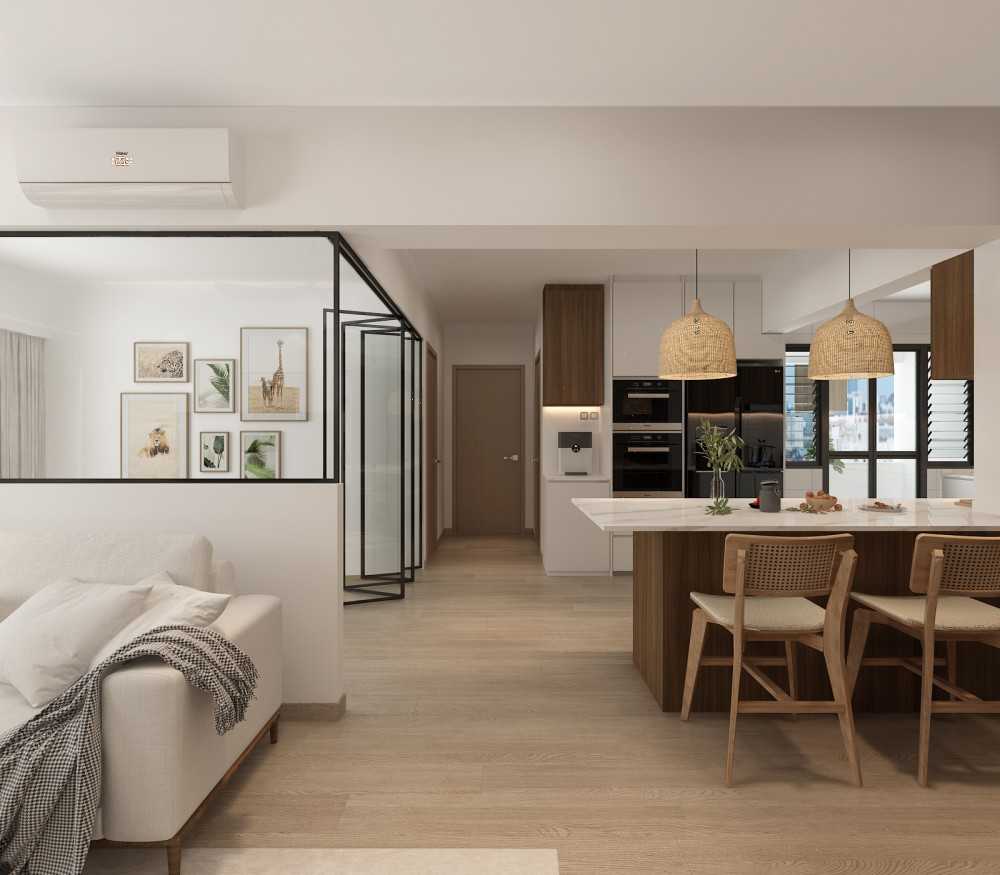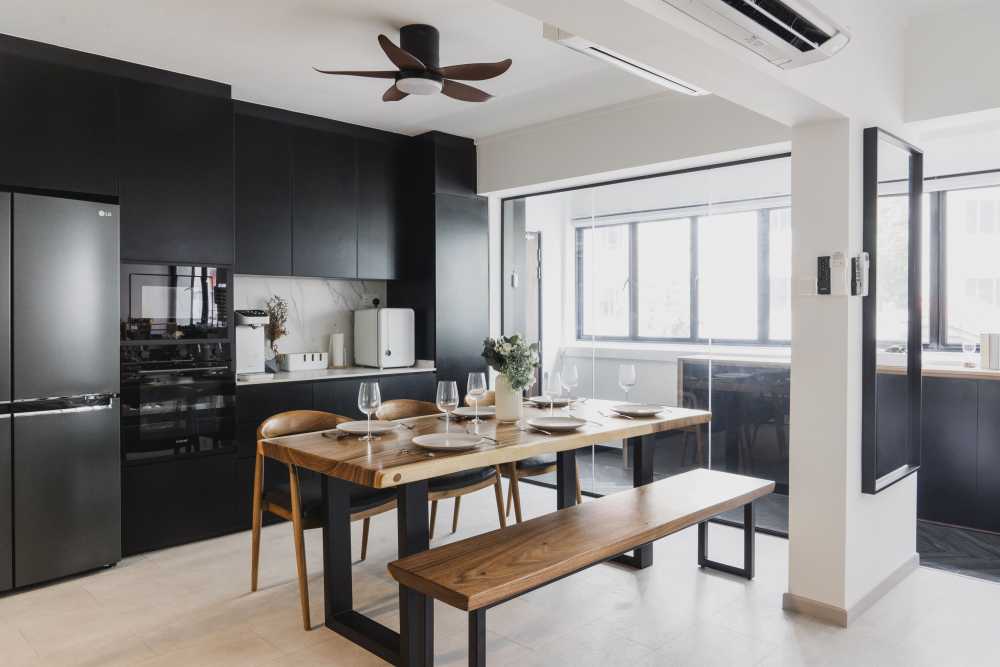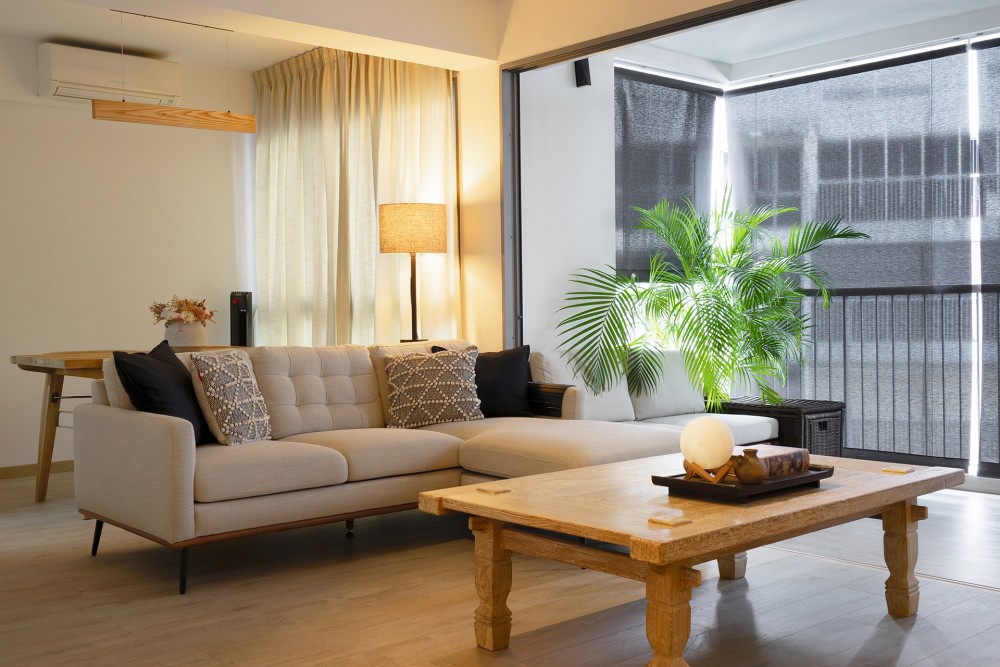Revamping Your Kitchen: Latest Trends and Practical Tips
The kitchen is often considered the heart of the home, a place where meals are prepared, and memories are made. Revamping your kitchen can significantly enhance its functionality and aesthetic appeal, making it a more enjoyable space for you and your family.
In this article, we’ll explore the latest kitchen design trends and offer practical tips to ensure your remodel is a success.
Latest Kitchen Design Trends
Whether you’re planning a full remodel or just looking to make a few updates, staying informed about the latest trends can help you create a kitchen that is both stylish and practical.
From innovative materials to smart technology and creative storage solutions, the following design trends offer inspiration for transforming your kitchen into a modern and efficient space.
Colour palettes
Choosing the right color palette is essential for setting the tone and atmosphere of your kitchen. Whether you prefer a calm, sophisticated look or a vibrant, energetic space, the right colors can transform your kitchen into a place you’ll love to spend time in. Two popular trends in kitchen color palettes include neutral palettes and dopamine decor.
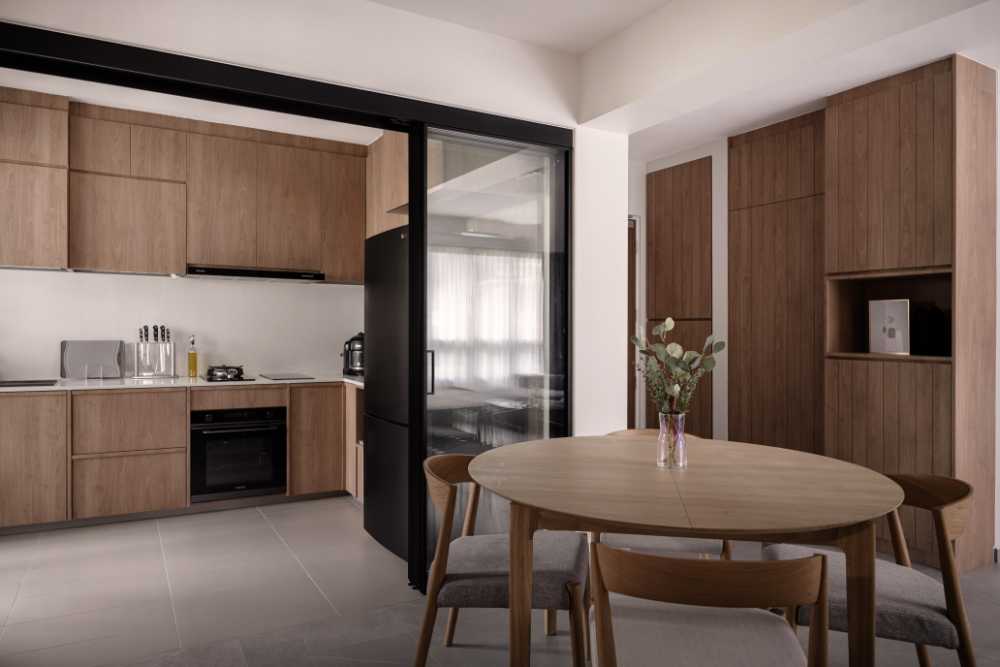

Dakota Breeze ($38,000) by PRDT Pte Ltd
Firstly, neutral color schemes remain popular for their timeless and calming effect. Whites, grays, and beiges create a clean and sophisticated look, serving as a versatile backdrop for various design elements and personal touches. These colors can make your kitchen feel spacious and airy while providing a serene environment.
In contrast to neutral palettes, dopamine decor embraces bright, maximalist kitchens filled with bold colors and eclectic patterns. This trend aims to create a joyful and energetic atmosphere, making the kitchen a lively and inviting space. Bright hues and playful patterns can add personality and vibrancy, turning your kitchen into a focal point of happiness and creativity.
Countertop materials
Choosing the right countertop material is crucial for both the functionality and aesthetics of your kitchen. While quartz has been a popular choice for many years, a new material has emerged as a favorite among homeowners and designers: sintered stone.
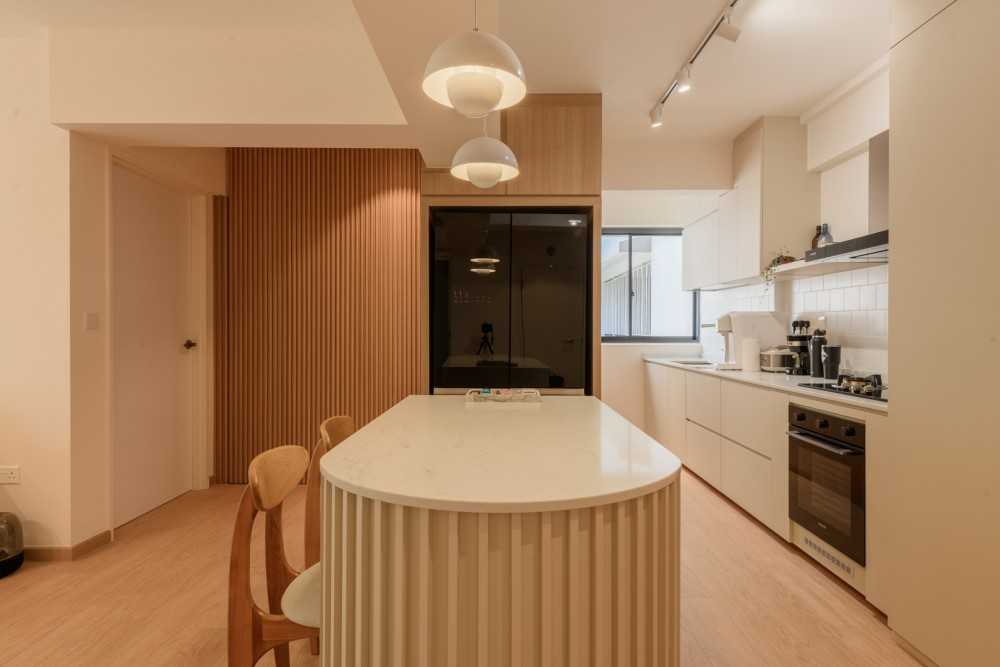

Bidadari Park Drive (Blk 104C) ($51,000) by Mr Designer Studio
Firstly, let’s talk about sintered stone. This material is crafted through a process that uses extreme heat and pressure to bond natural minerals, resulting in a surface that is exceptionally durable. It offers resistance to heat, stains, and scratches, making it ideal for the high demands of a busy kitchen.
Additionally, sintered stone has a sleek, modern appearance that enhances the aesthetic appeal of contemporary kitchens. While it is more expensive than quartz, many consider the investment worthwhile due to its superior durability and minimal maintenance requirements.
If you’re not a fan of sintered stone, quartz still remains a popular choice due to its durability, non-porous surface, and wide range of colors and patterns. As mentioned, it is less expensive than sintered stone, but still offers excellent resistance to stains and scratches. Quartz countertops are a practical and stylish option for many kitchens, providing a modern look that complements various design styles.
Smart Technology
Smart technology is revolutionizing the way we use our kitchens, making them more convenient, efficient, and enjoyable. Integrating smart appliances and innovative features can enhance your kitchen’s functionality and streamline your daily routines. Two key smart technology trends transforming modern kitchens include smart appliances and hidden kitchen hoods.
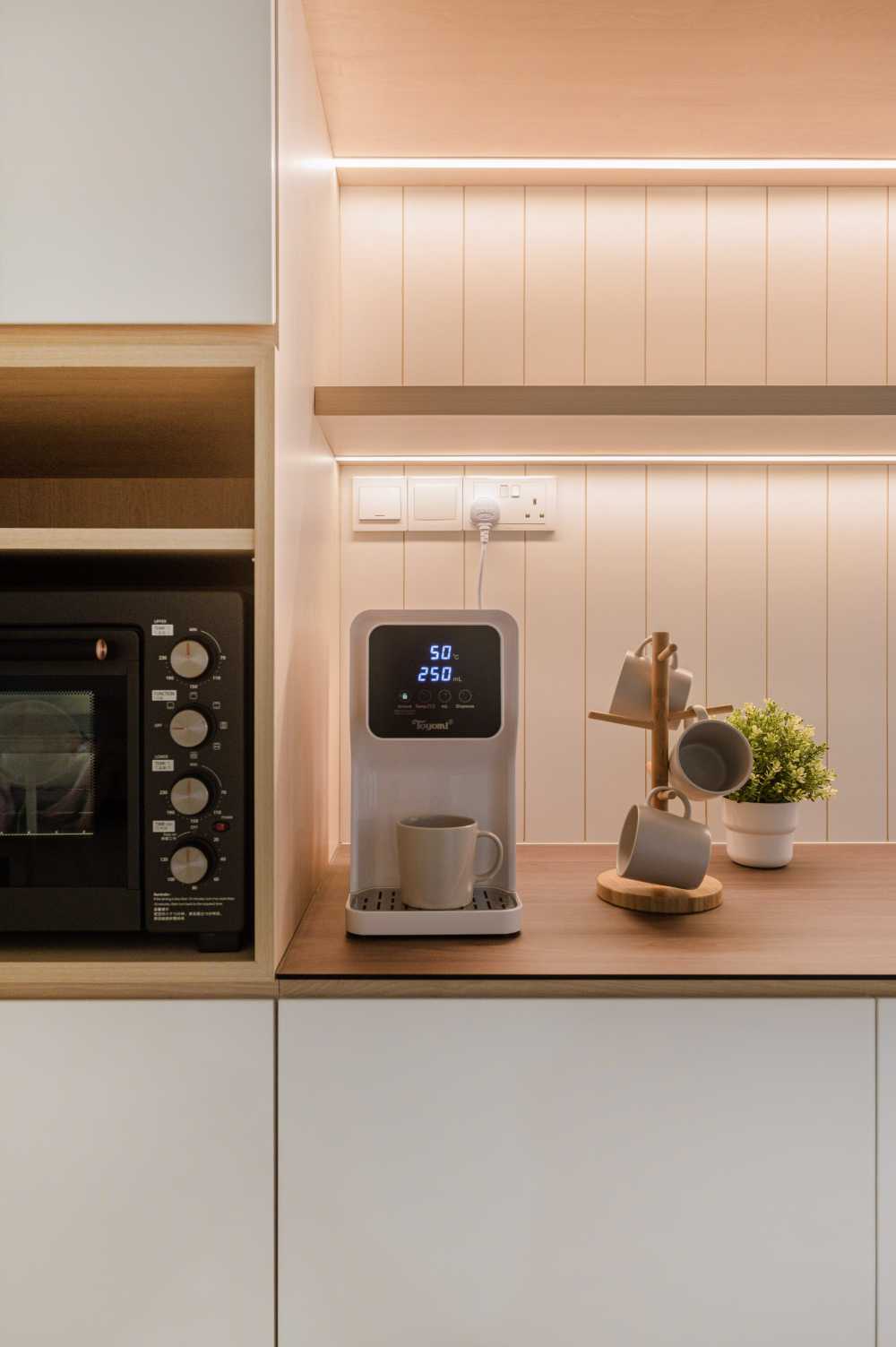

Ubi Grove ($45,000) by CO1 Studio
First, let’s talk about smart appliances. Modern kitchens are increasingly equipped with smart appliances like refrigerators, ovens, and dishwashers that offer advanced features for convenience and efficiency. Among these, smart fridges are often considered the most useful.
These fridges can be controlled remotely, provide energy usage insights, and even suggest recipes based on available ingredients. One of the most practical use cases of smart fridges is the ability to check the contents remotely. For example, if you’re grocery shopping and forget whether you have eggs, you can use your smartphone to check your fridge’s interior cameras.
On top of that, smart fridges can also track expiration dates, create shopping lists, and send alerts when items are running low, helping to reduce food waste and ensure you always have what you need.
Next, concealed kitchen hoods are gaining popularity for their clean and uncluttered look. These hoods are hidden vertically within the cabinetry and can be activated with a button. When activated, the hood slides out from the cabinet, providing effective ventilation while maintaining the sleek lines of your kitchen design. Once cooking is finished, the hood can be retracted back into the cabinet, blending seamlessly into your kitchen and preserving its aesthetic appeal.
These hoods are particularly suitable for kitchens where maintaining a minimalist appearance is a priority. They often come with smart features, such as automatic activation when cooking starts, adjustable fan speeds based on the level of smoke or steam, and quiet operation. This makes them both a stylish and practical addition to modern kitchens, offering powerful ventilation without compromising on design.
Note that while concealed hoods offer aesthetic benefits, they may not be ideal for all cooking styles. Heavy cooking, such as frying or grilling, can generate more smoke and require higher ventilation capacities than concealed hoods typically provide. Therefore, for those who regularly engage in heavy cooking, a traditional overhead hood with higher airflow capacity might be more suitable to effectively remove smoke and odors.
Instead, concealed hoods are well-suited for individuals or families who cook occasionally or prepare light meals such as salads, sandwiches, or quick stovetop dishes like instant noodles. They are also ideal for kitchens where aesthetics and space-saving are priorities, providing a seamless integration into cabinetry and maintaining an open and uncluttered kitchen environment.
Hidden Storage Solutions
Effective storage solutions are crucial in modern kitchens to maintain organization and streamline daily tasks. Hidden storage options not only enhance functionality but also contribute to a clean and minimalist kitchen design. Here are some innovative solutions to optimize space and reduce clutter…
Firstly, pocket door cabinets feature doors that slide into the sides of the cabinet, offering easy access and a streamlined appearance. These cabinets are ideal for concealing appliances like microwaves, blenders, or mixers, keeping countertops clear and maintaining a sleek kitchen aesthetic.
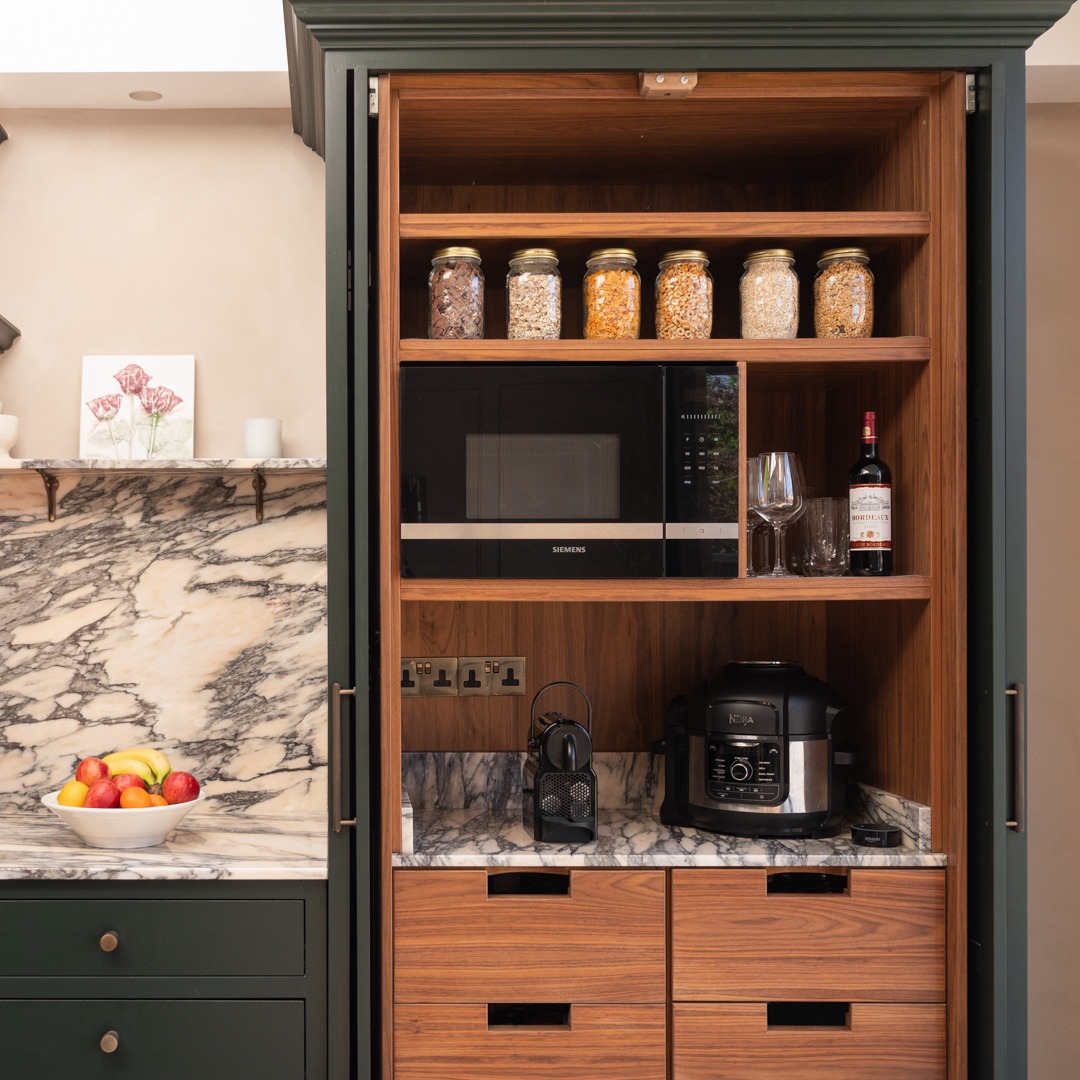

However, it’s important to ensure that the cabinet is sufficiently ventilated if housing appliances that generate heat. A gap around the appliance allows for proper ventilation and prevents heat buildup, ensuring the longevity of both the appliance and the cabinetry.
Beyond appliances, pocket door cabinets can also conceal a variety of items such as tableware and dinnerware, baking supplies, and cooking utensils. They provide versatile storage solutions that adapt to different needs while maintaining a tidy and organized kitchen environment.
Next, let’s talk about appliance garages. Similar to pocket door cabinets, appliance garages are dedicated spaces designed to hide small kitchen appliances such as toasters, coffee makers, or blenders. These spaces keep countertop appliances out of sight yet easily accessible when needed. Appliance garages typically feature retractable doors or roll-top covers, minimizing visual clutter and maintaining a clean kitchen surface.
Pro-tip: When planning the placement of pocket door cabinets and appliance garages in your kitchen layout, consider their accessibility and proximity to power outlets. Ensure that there are adequate power points nearby to accommodate the appliances stored within these concealed storage solutions.
If you’re unsure about the number of power points needed or wish to cater to future or expanding needs, consider using a power strip. A power strip allows you to add or remove power points as needed, providing flexibility and convenience for your kitchen setup.
Finally, let’s talk about pull-out pantries, which are another practical storage solution for maximizing space and organizing pantry items. These shelves slide out, providing easy access to items stored in the back. While traditional pantries are historically popular in countries like the United States with larger kitchen spaces and greater distances to supermarkets, pull-out pantries are gaining traction in Singapore due to their efficiency in smaller kitchen sizes.
In Singaporean kitchens, these pantries are typically designed shallower to optimize space efficiency, utilizing vertical height effectively while accommodating limited floor space. Homeowners may store their snacks, instant noodles, drinks and beverages, and other pantry items in these pull-out pantries.
Rounded Cabinets and Edges
Rounded edges have emerged as a popular trend in modern interiors, including kitchens.
In kitchen design, rounded edges on countertops and cabinetry create a softer, more inviting look while also making the space feel more fluid and less imposing. That said, the shift towards rounded edges is not purely cosmetic; it also addresses practical concerns.
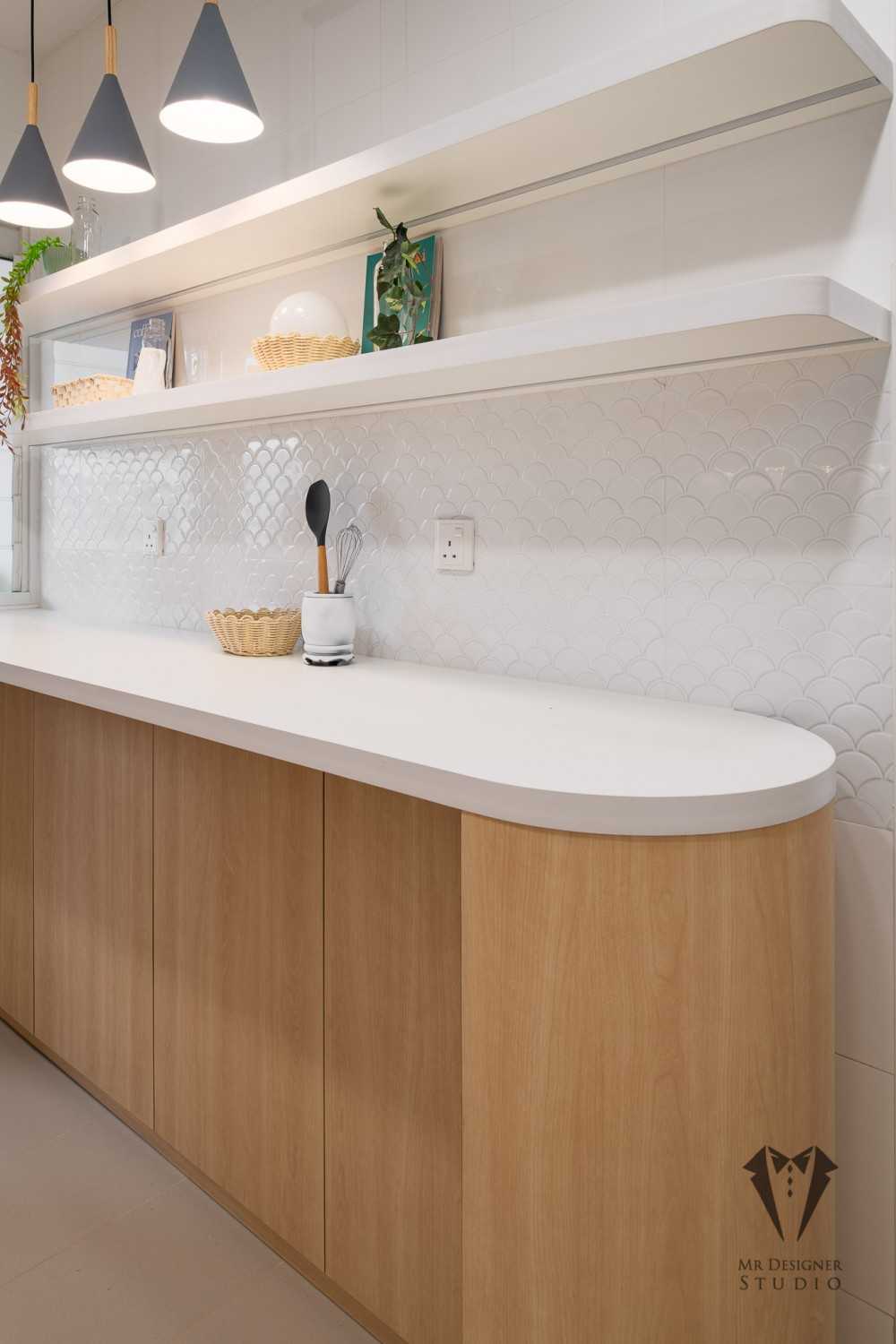

Tampines GreenVerge (Blk 624) ($58,000) by Mr Designer Studio
Rounded corners reduce the risk of injuries caused by sharp edges, making them ideal for high-traffic areas where people move around frequently. This feature is particularly beneficial for families with young children or anyone concerned about safety in the home environment.
However, integrating rounded edges into home design requires careful planning and consideration. The carpentry involved in creating rounded corners is more complex and labor-intensive compared to traditional square edges. This complexity can increase both material and labor costs, so it’s essential to factor this into your budget when planning a renovation or new construction project.
Extended Countertop Backsplashes
Instead of using traditional tile backsplashes, an increasing number of homeowners are choosing to extend their countertop material up the wall. This approach creates a seamless and cohesive look in the kitchen, enhancing the overall aesthetic appeal of the space.
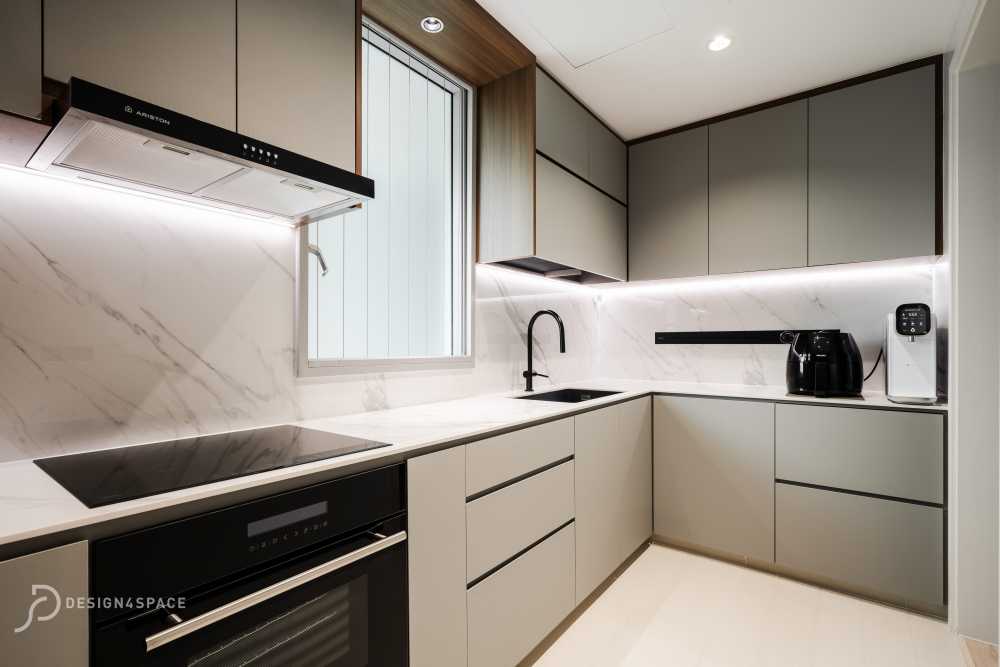

The Minton ($70,000) by Design 4 Space Pte Ltd
By extending the same material used for the countertop up the wall to serve as the backsplash, homeowners achieve a modern and streamlined appearance. This continuity in material not only visually connects the countertop to the wall but also eliminates the grout lines typical of tile backsplashes, which can accumulate dirt and grime over time.
From a practical standpoint, using countertop material for the extended backsplash may involve higher costs compared to traditional tile solutions. Countertop materials are generally more expensive per square foot than many types of tiles. However, some homeowners find that the investment often pays off in terms of durability, ease of maintenance, and aesthetic impact.
Practical Tips for a Successful Kitchen Remodel
Now that we’ve discussed the latest trends in kitchen design, we’ll share a couple of tips that will help you plan a successful kitchen remodel.
Tip 1: Start From Your Lifestyle
When embarking on a kitchen remodel, it’s crucial to align your plans with your unique lifestyle and practical needs. Consider these scenarios to tailor your kitchen setup accordingly…
Scenario 1: Family-friendly and multifunctional
Your Situation: You have young children and live in a small apartment. Your kitchen serves as not just a cooking space but a multifunctional hub for family activities.
Kitchen Setup: Designate areas where children can comfortably do homework or engage in activities while you prepare meals. Opt for durable materials and easy-to-clean surfaces.
Consider incorporating smart storage solutions to maximize space efficiency and keep essentials within reach.
Scenario 2: Perfect for hosting
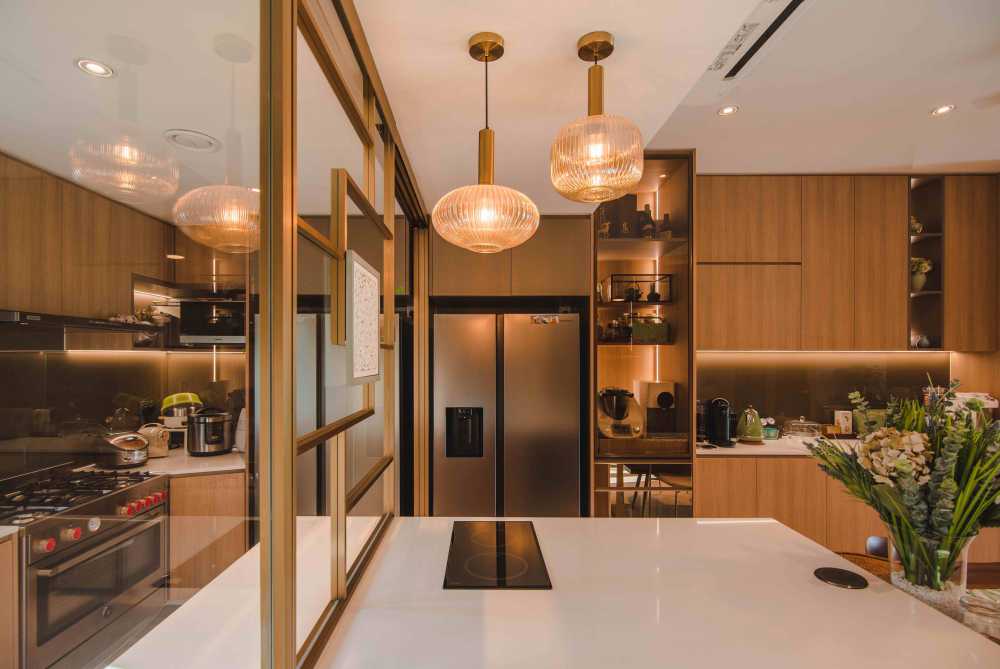


Hume Park Avenue II ($75,000) by De Style Interior Pte Ltd
Your Situation: You love hosting gatherings and enjoy cooking for friends and family. Your kitchen is the heart of social activities.
Kitchen Setup: Prioritize an open layout with ample countertop space for food preparation and serving. Include seating areas such as a breakfast bar or island where guests can gather and interact while you cook. Invest in quality appliances that support your cooking style and facilitate efficient workflow during gatherings.
Scenario 4: Just the basics
Your Situation: It’s just you and your partner, and neither of you cooks extensively. The kitchen is primarily used for simple meals and occasional cooking.
Kitchen Setup: Embrace a minimalist approach with streamlined design and essential functionality. Instead of investing in elaborate appliances, prioritize a high-quality microwave oven for heating meals quickly and effectively. Choose a refrigerator with a spacious freezer compartment to store essentials and frozen items efficiently.
Tip 2: Set a Realistic Budget
Before starting your kitchen remodel, set a realistic budget that accounts for materials, labor, and unexpected costs.
A great way to gauge how much you can get done for your money is to visit friends’ homes who have recently renovated their kitchens. Ask them about the extent of their renovations and the prices they paid. This firsthand information can provide a clearer picture of what to expect in terms of costs.
Keep in mind that pre-COVID and post-COVID prices are very different, with costs being significantly higher in the post-COVID era. This increase is due to supply chain disruptions, higher demand for home renovations, and increased labor costs.
Therefore, it’s crucial to account for these differences when planning your budget. Being aware of these factors will help you set a more accurate budget and avoid any unpleasant surprises during your kitchen remodel.
Tip 3: Maximizing Space and Storage
In Singapore, where apartments are often compact and space is at a premium, maximizing every inch of your kitchen is crucial. Here are some ideas:
- Utilize pull-out shelves to make the most of your cabinet space, allowing easy access to items stored at the back.
- Lazy Susans are perfect for corner cabinets, making it simple to reach all your kitchen essentials without wasting space.
- Drawer organizers can help you keep utensils, spices, and other small items neatly arranged, reducing clutter and increasing efficiency.
- Consider vertical storage options such as tall cabinets and shelving units to make use of your kitchen’s height.
- Install hooks and racks on walls or inside cabinet doors to store pots, pans, and lids.
By implementing these innovative storage solutions, you can create a more organized and functional kitchen, even in the smallest of spaces.
Tip 4: Consider Your Lighting Needs
Getting the lighting right in your kitchen is essential, and it’s one aspect that many inexperienced homeowners often get wrong. Relying solely on one type of lighting, such as overhead lights, can create shadows and make it difficult to see properly during prep work. Instead, combine ambient, task, and accent lighting to create a well-lit and inviting kitchen.



622B Tampines ($50,000) by JP Atelier Pte Ltd
Ambient lighting provides general illumination for the entire kitchen, setting the overall mood and ensuring visibility. This can be achieved with ceiling-mounted fixtures, recessed lights, or a central chandelier. However, ambient lighting alone may leave some areas dimly lit.
Task lighting is essential for illuminating specific workspaces where detailed tasks, such as chopping vegetables or reading recipes, are performed. Under-cabinet lighting is ideal for this purpose, as it shines directly onto countertops, eliminating shadows and providing clear visibility. Pendant lights over kitchen islands or dining areas can also serve as effective task lighting while adding a stylish touch.
Accent lighting adds depth and dimension to your kitchen by highlighting architectural features, artwork, or decorative elements. Consider installing strip lights inside glass-front cabinets to showcase your dishware or placing small spotlights to accentuate a backsplash or unique design feature.
By thoughtfully combining these three types of lighting—ambient, task, and accent—you can create a well-lit, functional, and aesthetically pleasing kitchen that enhances both the practicality and beauty of your space.
A Final Word on Revamping Your Kitchen
Revamping your kitchen is a significant undertaking that can transform the heart of your home into a space that is both functional and beautiful.
By staying informed about the latest design trends and following practical tips tailored to your lifestyle and budget, you can ensure a successful remodel that meets your needs and enhances your daily life.
Whether you’re incorporating modern materials, smart technology, or innovative storage solutions, careful planning and thoughtful choices will help you create a kitchen that is not only a joy to use but also a true reflection of your personal style.
Want to check out home renovation projects for more inspiration? Browse kitchen design ideas on Hometrust, or click the button below to get connected with expert designers!
Renovating soon? Let Hometrust recommend the best interior designers.
If you are reading this, you are probably wondering how you can create your dream home.
Here’s the thing, everyone’s needs and requirements for their home renovation is different. A designer that may work for someone else, may not quite work for you.
At Hometrust, we’re here to help match top rated designers, recommended by past homeowners to you through our data-driven and matching algorithm.
Whether you are looking for partial renovation or a full fledge overhaul, we’ll be able to recommend you top designers to match your renovation requirements and lifestyle.
Recommendations and free and you can simply start by helping us understand your needs below!
Get RecommendationsRenovate safe!
The Hometrust Team

